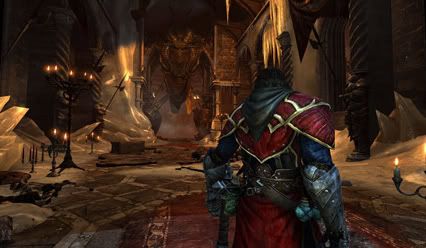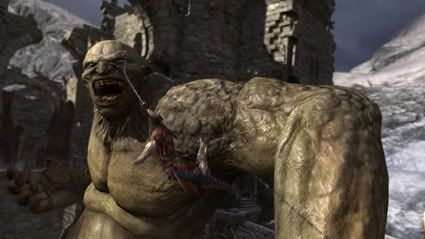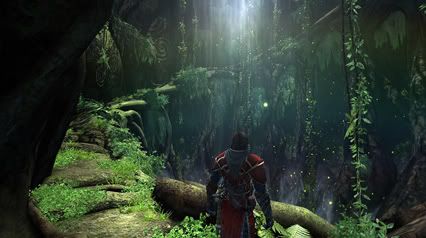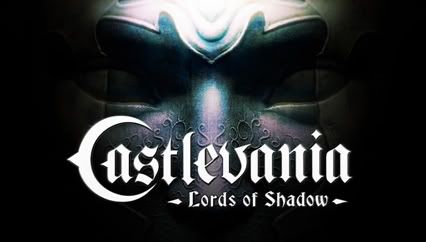- Format: 360 (version reviewed), PS3
- Unleashed: Out Now
- Publisher: Konami
- Developer: MercurySteam
- Players: 1
- Site: http://www.konami.jp/castlevania/
If Castlevania: Lords of Shadow were a pie, it’d be made from all the right ingredients – a deep, satisfying combat system (the crust), an epic, 15+ hour quest (the filling), and stunning art and graphics (the whipped cream) – but someone got the proportions wrong. The pie is runny, the crust is too crunchy, and the whipped cream is low-fat. It still tastes like a fine character-action game, but you have to make too many concessions to get anyone to eat it.
The biggest culprit is the frame rate. If you have a keen eye for fluctuations in frame rate you’re going to have a hard time with this game. It’s consistently too slow, and in heavy combat it gets even slower, eventually collapsing into full 2-3 second long pauses whenever you kill more than a couple of enemies at once.
It’s a shame because the game is god-damn gorgeous. But it’s also so visually dense that the choppiness makes it hard to process what you’re looking at half the time. If developer MercurySteam had turned down the insane fidelity just a notch, Lords of Shadow would still be a beautiful game and it wouldn’t leave your eyes feeling violated. As it is, the game still manages to look stunning. Nearly every set-piece is a richly detailed work of art – from colourful forests, to a frost-covered village and a massive castle, the variety and scope of the environments is awe-inspiring.
 As Gabriel Belmont, you’re on a quest to save the world and revive your recently deceased love. It’s a set-up designed not for an epic showdown with Dracula (he’s not even really in the game), but more as a supernatural epic to God of War’s Greek myth. Lords of Shadow accidentally stumbles into most of its Castlevania-ness simply by the very natural of character-action games. Yeah, you fight monsters with a whip-like weapon, smash the background for extra sub-weapons, and take on hordes of undead monsters, but that’s pretty much what you do in God of War and Dante’s Inferno as well.
As Gabriel Belmont, you’re on a quest to save the world and revive your recently deceased love. It’s a set-up designed not for an epic showdown with Dracula (he’s not even really in the game), but more as a supernatural epic to God of War’s Greek myth. Lords of Shadow accidentally stumbles into most of its Castlevania-ness simply by the very natural of character-action games. Yeah, you fight monsters with a whip-like weapon, smash the background for extra sub-weapons, and take on hordes of undead monsters, but that’s pretty much what you do in God of War and Dante’s Inferno as well.
Those games in particular (less than Ninja Gaiden or Devil May Cry) inspire the combat here. Your moves are showy and spectacular, and without staying two steps ahead of the enemies (and the frame rate) you’re bound to get lost in all the flashiness and let in some free hits. At first it’s a huge problem – the first few hours require some heavy risk-reward management against the tougher enemies. You’re more or less required to use counter-attacks, which is both a blessing and a curse. It’s good to learn the timing because you get huge bonuses that refill your magic. It’s a pain because the timing can be so unforgiving. If the frame rate is chugging, or the enemies just don’t like you at that particular moment, you’ll have to time your counter well in advance of the actual attack. It makes countering an anticipatory action rather than reactionary one.
As you progress you gain access to some devastating combos that take away some of the necessity for countering. With more moves to work with, the combat becomes a lot more satisfying. This is a problem in itself though, because you end up with a reverse difficulty curve – the game gets easier and easier as it goes, eventually culminating in a final boss encounter that seems almost impossible to lose.
 Still, you do get a lot of neat toys along the way, and Lords of Shadow has some novel ideas within its combat system. Early on you acquire light and dark magic, both of which can be activated at any given time (as long as you have the energy for it) and offer unique benefits. Activating light magic replenishes your health with each successful attack, while activating dark magic increases your attack strength. Additionally, each magic has its own set of devastating moves to unlock, and can be used in conjunction with sub-items to create, say, a holy water shield – pretty cool, eh?
Still, you do get a lot of neat toys along the way, and Lords of Shadow has some novel ideas within its combat system. Early on you acquire light and dark magic, both of which can be activated at any given time (as long as you have the energy for it) and offer unique benefits. Activating light magic replenishes your health with each successful attack, while activating dark magic increases your attack strength. Additionally, each magic has its own set of devastating moves to unlock, and can be used in conjunction with sub-items to create, say, a holy water shield – pretty cool, eh?
As you fight, enemies will release neutral energy that can be absorbed into either the light or dark magic meter. This would add a nice bit of resource management to the game, but it has some issues. Firstly, since light magic replenishes your health, you’re almost always going to go for that over dark magic. Secondly, you can’t absorb energy unless you stop fighting and hit either the left-stick button (for light magic) or the right-stick button (for dark magic) – the process is awkward and not all that fun.
While the combat is the focus of the game, there’s also a huge amount of platforming and puzzle-solving along the way. They do well to break up the action, but once again they come with their own share of issues.
 Gabriel’s platforming controls are imprecise, and the level design can be annoyingly vague at times. Cheap deaths abound, despite ledges that flash obnoxiously when you get near them. The experience is at odds with itself, meant to be a bit of quiet, atmospheric downtime but all too often a frustrating chore.
Gabriel’s platforming controls are imprecise, and the level design can be annoyingly vague at times. Cheap deaths abound, despite ledges that flash obnoxiously when you get near them. The experience is at odds with itself, meant to be a bit of quiet, atmospheric downtime but all too often a frustrating chore.
The puzzle-solving is straight out of Prince of Persia’s wheelhouse, with some tried-and-true puzzles (bouncing light on mirrors), some that are just tried (aligning rotating discs), and one or two genuinely novel challenges. In one you play a game of demonic chess against a pint-sized vampire, and in another you’re shrunk down into a music box, navigating it to the melody of a classic Castlevania theme.
There’s a lot of good stuff in Castlevania – too much even – but it never quite soars to the levels it should. It tries to stand beside the greats of the genre, and it tries damn hard, but there’s some polish missing from almost every aspect of the game. And then there’s that frame rate – seriously, if that stuff bothers you, subtract a point or two from the final score, it’s that bad. When the ending finally comes (stay after the credits, it’s awesome!), it’s hard to say you don’t get your money’s worth, but it’s not as fun as it could have been.


















Comments